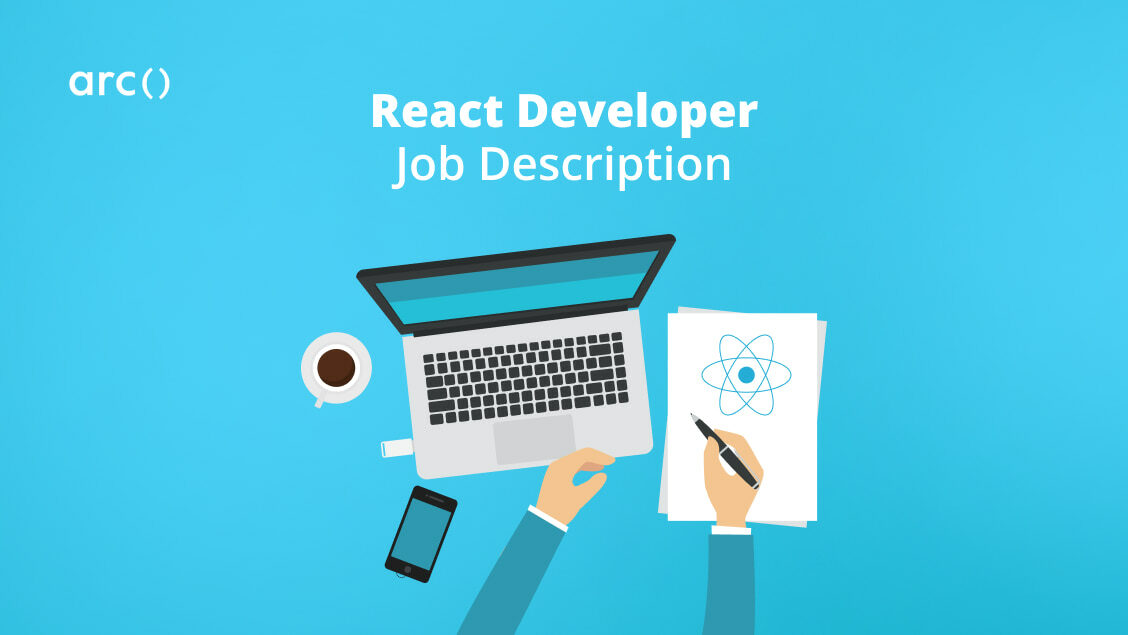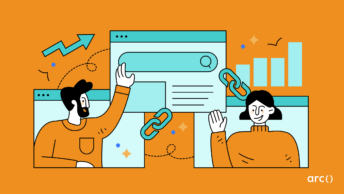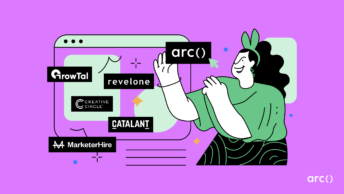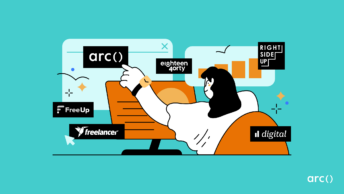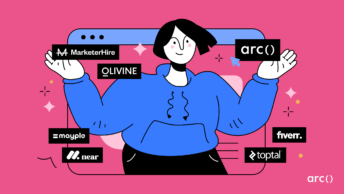Software engineering roles can be quite difficult to fill. For instance, if you’re looking for a seasoned React developer who’s capable of implementing and designing UI components for web and mobile apps, you’ll be competing with some of the biggest tech companies in the world. And these companies come with a lot of tech street cred and brand name recognition.
So, how can you be sure you’re filling your company’s ranks with the most skilled junior and senior React developers?
The answer: you need to write a compelling React developer job description.
With that in mind, we’ve concocted an in-depth guide on how to write a killer job description. We’ll provide you with everything you need, including:
- A React developer job description template to use as inspiration
- A step-by-step guide to writing a comprehensive job description yourself
- Advice on how to get React developers interested in your job listing
Let’s get to it, then!
Looking for top talent fast? See how Arc can help you:
⚡️ Find developers, designers, marketers, and more
⚡️ Freelance or full-time remote + fully vetted
⚡️ Save up to 80% with global hires
Hire top talent with Arc risk-free →
Sample React Developer Description Template
Before we get into specific details about how you can write a great React engineer job description, take a look at the example job description below to get a feel of what the end result should look like.
Also, feel free to copy, paste, and edit our template according to your needs!
Senior React Developer, LTC (Remote) About Us FrontView Solutions is a New York-based tech startup focused on creating accessible, functional, and easy-to-use web applications for all kinds of niches and industries. You’ll be joining a remote, global team that works on cutting-edge technologies with the goal of creating cost-effective online platforms for small and medium-sized businesses. What You’ll Do As a senior React developer at FrontView Solutions, you’ll help us develop components of the user interface and implement them through React.js workflows like Redux or Flux. Additionally, you will make sure that those user interface components are easy to maintain and robust. Also, you will coordinate with your team members who are responsible for various infrastructure layers. For this position, a deep commitment to sophisticated design, problem solving, and quality products is vital. Responsibilities • Reviewing interface designs and application requirements; • Discussing applications and user interface ideas with the development team • Identifying and enabling user interactions on a web platform; • Using React concepts to implement and develop responsive components of the user interface; • Following React.js workflows and writing application interfaces via JavaScript; • Debugging application code and troubleshooting interface software; • Developing and maintaining front-end architectures that support user interfaces; • Improving and monitoring front-end performance • Developing updates and documenting application changes. Necessary Qualifications • Proficiency in frequently used React tools like Flux, Redux, webpack, etc. • Bachelor’s Degree in Mathematics, Computer Science, or any relevant alternative training in computer programming; • 3-6+ years of experience in front-end development • In-depth knowledge of the development of web-based user interfaces with React.js, Javascript, and Typescript Nice-to-Have Qualifications • Practical knowledge of REST endpoints and APIs • Familiarity with AWS serverless architecture • Experience with NoSQL databases • Experience with back-end technologies • Practical knowledge of GIT and similar version control systems Compensation and Benefits • Competitive base salary • Paid parental leave • Unlimited paid vacation • Yearly stipend for remote work • Retirement plans & stock options • Dental, medical, and vision insurance • Paid self-development courses and gym membership Reach Out! We’re a wholesome company that aims to build a mutually respectful work environment on the basis of diversity and inclusion. Our global teammates are the most important resource of our business, which is why we emphasize work-life balance and personal well-being. We aim to recruit, retain, and develop the most talented React.js developers from a global and diverse candidate pool — and if you want to be a part of this kind of dev-focused work environment, get in touch with us today!
At this point, some caution is warranted: you can’t copy an example directly and expect to get great results. There are plenty of specifics that you’d need to alter for your specific position, and various changes you could make to ensure the job description perfectly suits the tone of voice and brand of your company.
Don’t cling to any templates too much, and always do what’s sensible for your company and the specific position you’re offering.
Check out our entire set of tech job descriptions and choose the one which fits your hiring needs best:
- Software Engineer Job Description
- Python Developer Job Description
- Front-End Developer Job Description
- Angular Developer Job Description
- Back-End Developer Job Description
- Cloud Architect Job Description
- JavaScript Developer Job Description
- AWS Cloud Engineer Job Description
- AWS Cloud Practitioner Job Description
- AWS Cloud Architect Job Description
- Scrum Master Job Description
- Full Stack Developer Job Description
- Node.js Developer Job Description
- Cloud Engineer Job Description
- DevOps Engineer Job Description
- Web Developer Job Description
- React Developer Job Description
- Ruby on Rails Developer Job Description
- Agile Product Owner Job Description
- Agile Project Manager Job Description
- Remote Developer Job Description
Or, say goodbye to writing job descriptions altogether with HireAI. Discover top remote developers instantly without manual searching and screening. Try HireAI now!
How to Write a React Developer Job Description
After you’ve seen what a great React job description looks like, we can go over all its sections in more detail. The structure has some flexibility to it, but remember that a job description is design to attract attention. So place the most important information where an applicant will glance first. Make the applicant’s reading job as easy as possible!
Use the sections we’ve outlined below as a mere starting point. For instance, if you’re a recruiter for a FAANG company, chances are you won’t need to write a description of your company. And you don’t need to include everything we’ve listed either — many developers find huge job descriptions a turn-off.
When you’ve finished writing, sit back, read through, and ask yourself: does this get to the point? Does it clearly show how the company is attractive? And is it clear what kind of developer we’re looking for?
And never forget to give it a proofread before posting. Typos are unprofessionals in resumes and in job descriptions.
1. Job title
Naturally, the job title is the first thing you want to include — and its role is quite important. After all, it’s the first thing your candidates will see on job boards like Indeed, LinkedIn, or ours right here at Arc.
On any job board, a prospective candidate will encounter dozens, or even hundreds of similar titles. That means you need yours to stand out and compel the candidate to click through from their main search page. In other words — a great, punchy job description title is really important.
Here are a couple of examples:
Bad Example:
React Engineer
Good Example:
React.js Senior Developer – Web Applications – Front-End (Remote)
And yes, short titles can draw someone’s attention as well — but you want the job title to be descriptive. Candidates will want to know some information right away, such as the seniority level you’re looking for.
Always include some essential qualifiers like:
- Type of React.js developer
- Seniority level
- The sub-field or area you need a candidate for (such as web applications or mobile applications).
If you want to get more descriptive, you may also include:
- Location (on-site, remote, hybrid)
- Required frameworks, technologies, or languages
- Company division and name
Take into account the context of the job board. What do the other titles look like? And: if you’ve already included tags or filters specific to the job board, it may not be necessary to re-include this information in the job title itself. Use your judgment.
2. About Us
As a hiring manager or recruiter, you’ve got one goal — attracting qualified candidates to your React.js job ad. However, the best talent always wants to work for the best companies, which means they’ll want to know who you are before taking the time to apply.
So, write up a short company description — nothing fancy, and nothing too detailed; just a couple of paragraphs at most, highlighting the company’s products or services and the company culture. Describe the values your workplace is built on and something that sets your company apart from the competition.
Here’s a compelling and simple “About the company” section from a Kriptomat, a company recently hiring React.js developers:
Kriptomat is a fintech company headquartered in Tallinn, Estonia. Ever since we got founded in February 2018, we have been growing and providing an unparalleled service to our clients. We are working tirelessly to ensure everyday people can purchase, store, send, and receive cryptocurrencies effortlessly. This movement has just begun, and we look forward to providing our crypto community with outstanding solutions for many years to come.
It’s clear, concise, and to the point — you don’t need to tell your company’s whole history, just a few tidbits of information that’s actually relevant to candidates.
3. Role summary
Next up, you’ll want to include a short paragraph that gives candidates a high-level overview of their potential React Developer role at your company.
You’re hiring software engineers, and software engineers know the essentials of what the job entails. Here’s an excellent example of a React role summary from Piper Companies via Indeed.com:
You will design, develop, test, and debug software, and your efforts will be critical to ensuring we are building and deploying code that meets the ongoing needs of our clients. You will work closely with cross-functional departments to understand and develop project requirements. This is a 12 Month CTH.
4. Duties and responsibilities
While everyone likes having a high-level overview of the job role they’ll be applying for — they also want to know what their everyday work will look like.
Now, this isn’t necessarily a separate section — you can just as easily roll it into the role summary we’ve discussed above. However, if you’re choosing this approach, consider making it into a bullet-point list.
Mention the candidate’s general daily activities, some of the processes they’ll likely be implementing, and some of the tools they’ll use to do so. Here’s a great example we’ve found for a React.js engineer role at SpineZone via Indeed.com:
• Work closely with engineering and product teams to work through bugs/issues, collaboration, and ideation • Deliver top-tier solutions with minimal guidance. You also recognize when you're wrong, learn from your mistakes, and move past them. • Manage the translation of visual and written designs into efficient front-end components/pages (HTML, CSS, JavaScript etc.) on the user interface • Oversee the architecture and implementation of robust client-side solutions involving custom React components, JSON, AJAX, REST • Conduct unit and integration testing to make sure the interface performs on all devices and degrades gracefully in older browsers • Embrace best practices and are always searching for opportunities to continually improve, learn and grow. • Enjoy working with people and empowering everyone to do the best work of their life by ensuring they can leverage technology to serve them.
Necessary skills and experience
Also referred to as “work experience,” “requirements,” and “core qualifications” — this section is supposed to clearly state what kind of expertise and skills your company expects from candidates. It’s a good idea to include a bulleted list here too.
Here’s a good example from an Oracle job ad for a React Frontend engineer listed on Indeed:
• Bachelor or Master Degree in Computer Science or related field. • 1+ years of experience as a Frontend/JavaScript Engineer. • Strong communication and problem-solving abilities. • Proficient with cross-browser HTML and CSS. • Proficient with vanilla JavaScript and modern JavaScript frontend frameworks including React and Redux, Angular or Vue.js, and tools such as Webpack.
It’s important not to go overboard while listing your requirements — only include skills and qualifications whose absence would be an absolute deal-breaker. The more you include, the more potential applicants will self-exclude — which reduces your chances of successfully making a hire.
6. Nice-to-have skills
While the previous section contained all of the skills candidates must have to be considered for a React job position, this section includes some “extra” and “preferred” qualifications that aren’t strictly a requirement. By creatively using this section, you can help candidates understand more about the role — and how they can stand out.
Here’s an example from a Front-end developer job ad at Formstack via Glassdoor:
Bonus Points: • Knowledge of module bundlers • Familiarity with Redux • Familiarity with CSS preprocessors or modern CSS toolchains (PostCSS) • Experience working on a SaaS product
7. Requirements on formal education and certification
These days, including strict education requirements in React.js job description is not really advisable. Both Silicon Valley and the tech industry in general are full of self-taught React.js engineers and people that obtained their expertise through non-traditional avenues of education — such as through coding bootcamps. In general, it’s better to focus on the results that a candidate is expected to reach rather than a formal educational background.
Of course, if your company has formal guidelines on this, follow them. Make sure to point out the lowest level of required education, which will usually be a bachelor’s degree, as well as any specific areas of study — like computer science or computational mathematics.
8. Working location and time
More and more React.js developers and software engineers in general are looking for remote work opportunities — which is why it’s important to clearly state whether you’re looking for an:
- On-site employee,
- Hybrid working arrangement, or
- Someone to fill a remote position.
And speaking of location, if you’re only hiring candidates from a specific country or region, make sure to state that in the job description.
It’s vital to pay attention to scheduling as well — will prospective candidates have to overlap with their team’s work schedule completely, or for just a couple of hours? Or do you allow for completely asynchronous work? Most React engineers and software developers appreciate flexibility greatly, making flexible schedules a great draw for top talent.
9. Compensation, benefits, and perks
As you might have surmised from our sample React job description above, this is quite self-explanatory — so we’ll just give you a couple of ideas by listing some of the most common types of benefits:
- Remote work stipend
- Subscriptions: magazines, gym memberships, newspapers, etc.
- Referral bonuses for new talent
- Retirement savings programs and 401(k)
- Bereavement and sick leave policies
- Parental leave policies
- Performance-based bonuses
- PTO (paid time off) policies
- Annual salary range
- Professional development reimbursements
- Spending accounts like HSA, FSA, etc
- Regular company lunches, social events, happy hours, etc.
- Hardware and software
- Equity, stock options, ownership
- Health coverage
- Team building activities and company retreats
- Tuition reimbursements
10. Looking ahead: an employee timeline
This isn’t a strictly necessary section, but React.js developers (especially juniors) always appreciate having a rough outline of potential career progression within the company. Not only will this help them understand the company’s expectations better, but they’ll also have a better idea of how to measure their success.
Here’s an excellent example from a Frontend Developer job description at Encoura via LinkedIn:
Role Progression and Impact This role supports Encoura’s public-facing websites that serve higher-education clients (Encoura), students, families and educators (myOptions and Encourage). Our primary goal is to help all students achieve higher education and career success—meaning that millions of people will not only see your work, but your work will help people create the future they envision. Within 1 month, you will be contributing solutions for ongoing web initiatives, working hands-on to refine our agile development process while learning our business, culture, and getting to know your teammates. Within 3 months, you will be actively participating in planning and strategy projects and supporting our web transformations through the implementation of excellent UI, valid code, and interesting interactive elements. You’ll help us determine the success of our efforts through testing and analysis. Within 6 months, you will have defined our standard UI commitments and have taken ownership over ensuring a consistent web experience for our users and offering new ideas for how to continuously improve. You will own our technical SEO strategy and will ensure our website is completely WCAG 2.1 AAA compliant. Within 1 year, you will be fully immersed in an agile development process that consistently produces new web experiences that move our business forward, with a heavy emphasis on proving success through testing and analysis. You will provide leadership in user experience (UX) design beyond UI design. Another increasingly-common approach is describing “Your First 90 Days” — and how the new developer should use them, what they should achieve, and key milestones.
11. Other sections of the job description to consider
All of the sections we’ve outlined above ensure that your React.js job description will be both comprehensive, easy-to-read, and compelling to any top-talent candidates. That being said, there are some additional (and optional) sections you could consider including, such as:
Key dates — if this is not clear right away, make sure to point out when the job ad will expire, as well as any fixed starting dates for the position.
How to apply — many companies prefer to use their own application forms, instead of the built-in ones found on job board websites. If that’s the case, make sure to include a “how to apply” section at the end of your job ad so that candidates can follow the proper channels.
Legalese — if any national or local laws compel you to include certain disclaimers about data processing, privacy disclosures, equal employment opportunity statements, or similar legalese, don’t forget those sections to remain compliant.
Point of contact – if you want to, leave your contact information and name in case candidates have additional questions about the role. It’s a great way to get direct feedback on your recruitment process, but it’s also an excellent method of showing your dedication and “bedside manner” to the candidates right away.
Employment type — not necessary for full-time positions, but if you’re looking to fill a freelance or a part-time position, make sure to state so clearly in a separate section.
Tech stack — while React.js engineers will obviously work with React and JavaScript in general, they’ll want to know the entire tech stack even if it’s not strictly necessary for their particular role.
Hiring process — especially if your hiring process is particularly thorough or you’re looking for senior React.js developers, make sure that applicants know what to expect. Candidates always appreciate knowing all the steps until the last round in advance, especially if they have to prepare for whiteboard interviews or live coding sessions.
You can also try Arc, your shortcut to the world’s best remote talent:
⚡️ Access 450,000 top developers, designers, and marketers
⚡️ Vetted and ready to interview
⚡️ Freelance or full-time
Try Arc and hire top talent now →
Tips for Writing an Attractive Job Description for React Developers
1. Be inclusive
When you’re writing any kind of job posting, it’s imperative that you ensure it’s not discriminatory. Today, inclusive language is one of the cornerstones of any workplace — and it’s a practice that should already start at the job posting. Once you write your job ad, review the role description and job title in search of any language that could be interpreted as biased, even unconsciously — especially against people of color and women.
While these kinds of biases are usually unintentional, steering clear of certain phrases and words is important when writing your React.js developer job description, especially in the tech industry. If you want to run a check to ensure your job description text is free of biased terms, use platforms like Textio or the free Gender Decoder.
2. Make sure your React developer job ad is easy to read
Rather than making your job a bunch of large blocks of text, ensure that it’s formatted in an easy-to-read, skimmable, and eye-pleasing way. If candidates can’t quickly scan the posting for the specific information they need, they’ll be less likely to a) read it and b) actually apply afterward.
For that purpose, use proper formatting — such as headings and subheadings that divide the job ad into clear sections. Also, bolding or highlighting the most important information isn’t a bad idea. For easy reading, remember to use bullet-point lists wherever it makes sense to do so.
If there are any specific pages on your company’s website that could inform candidates further, feel free to link to them right there in the ad. Common examples include “About Us,” “Company Values,” and the company blog.
3. Be direct and engaging
To make your writing as engaging as possible, speak directly to the candidates rather than using the third person.
For example, instead of saying something like:
“Our ideal candidate for this opening is…”
It’s a better idea to use:
“You’d be a great addition to our team if you have…”
4. Include a specific instruction to filter applicants
With any kind of job description (especially for junior, entry-level positions), you’ll encounter plenty of candidates that aren’t particularly interested in your specific company. Instead, they’re applying to various positions en masse. This is rarely your ideal candidate, especially if they suffer from a lack of attention to detail as a result.
However, filtering out these candidates is easier than you think. All you need to do is to include a specific instruction that all careful applicants will follow. For instance, this could mean including the job ads’ ID number in their email’s subject line — or sending documents to a specific email address instead of applying on the job board directly.
5. End the job ad with a call to action
At the end of the day, your React.js job description is supposed to sell your company (and the specific position) to top talent — the very best candidates. So, you’re actively trying to convert high-level job seekers into applicants.
With that in mind, make sure to end the job description with a compelling call-to-action (CTA); something that will entice any qualified reader to apply.
You can also try Arc, your shortcut to the world’s best remote talent:
⚡️ Access 450,000 top developers, designers, and marketers
⚡️ Vetted and ready to interview
⚡️ Freelance or full-time


